 Technology Enhanced Learning Overview
Technology Enhanced Learning Overview
Roland Klemke, Open University of the Netherlands
Mikhail Fominykh, Norwegian University of Science and Technology
Viktoria Pammer-Schindler, Graz University of Technology
Abstract: This chapter aims at introducing the field of technology enhanced learning (TEL) with a bird’s eye view on the whole field by looking into some of the overall approaches that we have without covering all of the different aspects that we have in this field in detail. We want to highlight some of the challenges that we are facing in TEL Further, we want to focus on the typical “entry situation” that new PhD candidates find when they approach their PhD research in TEL, given that TEL is an interdisciplinary field, where ideas, approaches and methods from various fields come together and potentially collide.
What is TEL - definitions
The term Technology-Enhanced Learning (TEL) was coined in the context of working groups initiated by the European Commission in 2000. It is now broadly used to designate “a field of research aiming at improving learning by integrating current technologies and designing innovative ones” (Bourdeau & Balacheff, 2014). According to Kirkwood and Price, the term has been used since around 2005 to describe a research focus concentrating on the impact of technology on learning (Kirkwood & Price, 2014). While TEL is a standing term in European research, sometimes its related expressions are preferred internationally, such as Educational Technology, Digital Education, and Learning Engineering.
Interdisciplinarity of TEL
All terms and definitions recognize the need of epistemic fluency to facilitate interdisciplinary dynamics, in which participating professionals have “the capacity to understand, switch between, and combine different kinds of knowledge and different ways of knowing” (Lina Markauskaite, 2016). TEL is an interdisciplinary field that connects Computer Science with the Learning Sciences, Psychology, and other Social Sciences, Humanities, or Engineering Sciences (Meyer et al., 2013), (Tchounikine, 2011), (Kalz & Specht, 2014).
According to Conole et al., Kalz & Specht and Scanlon & Taylor, the research focus of TEL has led to interdisciplinary perspectives integrating theories and methods (Conole et al., 2010), (Kalz & Specht, 2014), (Scanlon & Taylor, 2016). Pammer-Schindler et al. describes TEL research as an intersection of Learning Sciences, Educational Psychology, and Computer Science, investigating interventions based on digital technologies in education and training settings (Pammer-Schindler et al., 2020).
TEL as a field of research
As a field of research, TEL is concerned with investigating how technologies can be used to enhance learning- and teaching-related processes, and thereby facilitate better outcomes; as well as with developing technologies that improve learning- and teaching-related processes and outcomes. Subsequently, TEL research asks all kinds of research questions: explorative, descriptive, analytical, predictive, interventionist, design-oriented, normative, or artistic. TEL researchers use a wide range of data collection and analysis methods, such as quantitative or qualitative, inductive or deductive.
TEL as a field of study
The term TEL has not only been used to describe a research domain, it has also been the foundation for a number of higher education study programs (Orey & Branch, 2017). This landscape has been characterized as continuously changing (Dennen & Spector, 2007), (Spector, 2015). A systematic analysis of master study programs in TEL found that their curricula rely on subjects of educational sciences and management of TEL in an organization, while the share of technological subjects is relatively small (Fominykh et al., 2022).
TEL in practice and digitalization
The term TEL also refers to a learning activity when it is supported by technology in practice. Such practical application of TEL has become known as digitalization of education that is implemented on all levels across Europe. However, digitalization trends are diverse, rapidly changing, and often without a clear application idea for practice. Thus, educators continue traditional forms of teaching. Often no sufficient consideration is made of the long-term consequences that investments in technology entail. There is thus an increased need for experts in TEL covering pedagogical expertise on using technologies for learning, technological expertise in designing technologies for learning, and strategic expertise in policy making and change management at institutional and societal levels. These TEL experts thus need “the capacity to understand, switch between, and combine different kinds of knowledge and different ways of knowing” (Lina Markauskaite, 2016).
Why doctoral education in TEL is needed
Digitalisation requires pedagogical expertise on using and technological expertise in designing technologies for learning, and strategic expertise in policy making and change management. However, stakeholders currently lack combined knowledge from all three perspectives, on how to strategically drive and operationally implement digitalisation of learning and training, envision innovative technologies for learning, and rigorous methods to create evidence for the effectiveness and efficiency of technologies as part of socio-technical interventions. Such expertise is required at all levels and at all types of organizations. There is also a growing, recognised understanding by all relevant stakeholders from EU policy makers to local schools that the potential of technologies with respect to learning is to provide ubiquitous access to learning materials,and an engaging, personalized and scalable learning experience.
Doctoral education in TEL aims to develop such expertise in doctoral candidates. It provides knowledge from multiple relevant perspectives and allows taking empirically-based decisions in implementing TEL solutions in practice.
Technology enhanced learning: how do we approach it?
Further in this chapter, we will explore two problem areas: the TEL field itself and its research approaches. The essence of this section is also available as a recording of a webinar organized in 2021.
We will use the keywords technology, learning, and enhanced and the corresponding abbreviations T, L, and E as a guideline throughout this chapter. We will look at them in different orders and this order matters. Technology and learning are typically quite clear, as they refer to disciplinary approaches from e.g. computer science or educational sciences. We do not yet really know what the enhancement is about from a research perspective.
Problem area 1: TEL field itself
Interdisciplinarity vs individual background
Due to the interdisciplinary nature of the field, people working and researching in TEL usually either have a technological background in computer science or related fields, or they come from educational science related fields. Some people are rather on the “T”-side, others are on the “L”-side. The mysterious field in the middle is something that we need to look into. So what is happening here? What does “enhance” mean?
As TEL is a field where we work in an interdisciplinary manner, we combine aspects of technology with aspects of learning: theories, technologies, innovation, ideas, concepts, research methods and approaches.
At the same time, TEL covers emerging fields and rather traditional fields, which comprise e.g.: how do design online learning and assessment? How do we use artificial intelligence for online learning? How do we use augmented & virtual reality? How do we structure learning materials to keep them motivating, to keep them attractive, to have interaction in online learning?
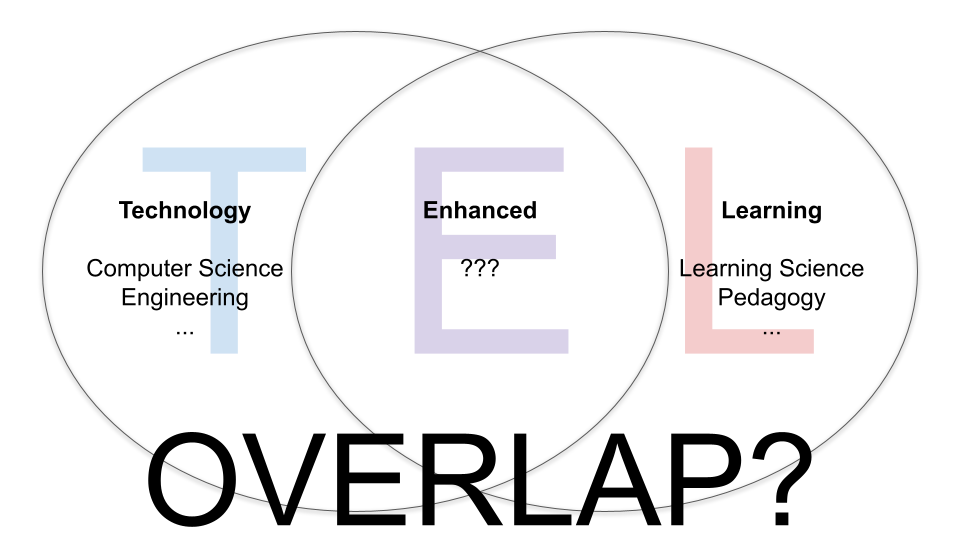
Research Goals
Within TEL research, we can distinguish a number of typical research goals. Educational sciences motivated research typically looks into learning effects, knowledge gain, learning efficiency, mastery or further related fields. From this perspective we apply technology to support these goals.
On the more technological side we have different goals that we look into: is a system feasible? Is it reliable? Can it interoperate with other systems? Is it scalable? Can we keep it secure? Technological innovation is the driver in these cases.
At the core of TEL research, we want to combine both perspectives. This leads to combined approaches that add further goals to the two previous perspectives: Is a learning system usable? Do users accept it? Is it motivating to work with it? Does it provide a satisfying user experience? This adds a system design perspective and includes learner experiences into the landscape of research goals. All three perspectives combined describe core goals of TEL.
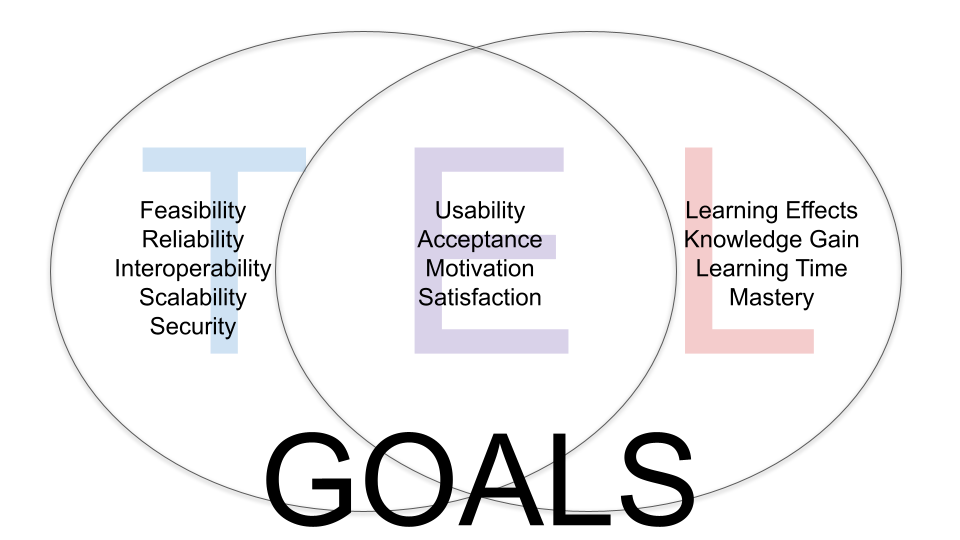
Research Methods
Corresponding to the multitude of research goals, also different research methods can be applied to measure the degree of achievement of the chosen research goals.
In learning sciences we use learning design or similar design-based approaches to create learning materials, learning offers, learning programs and then we test them. We use pre-post tests, assessments, observations, or interviews to check if learners get along with what we do. These methods exist in qualitative and quantitative variants.
Software engineering, system design, interaction design are approaches to develop an architecture, a proof of concept, or a prototype. We create standards for interoperability, measure performance and do stress tests of systems to evaluate technical aspects of a system.
In TEL, we are also interested in the enhancement to find out what a specific technology contributes to learning. Methods that relate to this e.g. comprise usability studies or acceptance measures. Questionnaires allow us to assess user perception, but we can also track users with technology and observe what they do with a system.
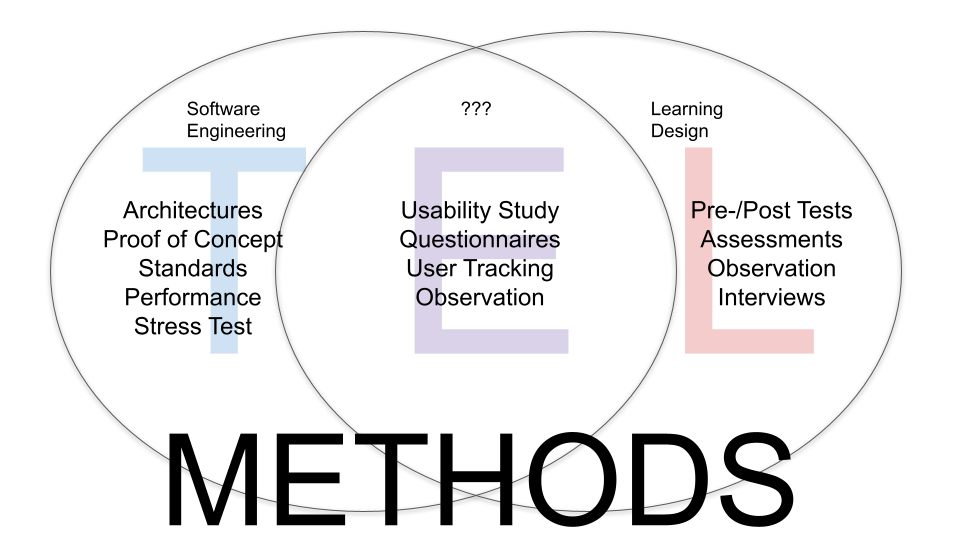
PhD research in TEL
When you are starting your phd research some of the questions you will be confronted with comprise:
- What is your research context?
- Which problems, questions, and goals are you addressing?
- Which methods do you apply to do so?
- How do you use these methods?
- What is the target of the research group you are connected to?
- How do they address technology enhanced learning?
- Are you in a technology group that has learning as an application field or are you in a learning science environment where you use technology to do research?
- Or are you in any other setting where you use TEL to improve a situation?
- What is your own approach?
- Which methods can you apply and how do they match what you what you aim to research?
When it comes to your PhD research in TEL and the corresponding need for doctoral education, this essentially boils down to: How do you know if you as a PhD student will be able to use and apply these methods? Where are your personal gaps?
What do you think where in the spectrum of T E L are you situated? Are you rather a technology person? Are you rather a learning science person? Or are you actually an enhancer in the middle?
Problem area 2: Research approaches in TEL
Research Approaches in TEL
Why do we ask these questions? As TEL is an interdisciplinary field, it combines research approaches from the connected domains. Typically, in TEL research we combine these, which requires the corresponding background knowledge. In the following we will discuss three different approaches of how research in the in the TEL field can be done. This by no means claims to be a complete set but these are prototypical approaches that we regularly find.
Theory-driven Approach
Let us look closer at the theory-driven approach. It is typically relevant for those of you who classify themselves as an “L”. In that approach you typically start with a learning problem. You select a learning theory that helps to address this problem. From there you start designing an intervention based on that learning theory to test whether it would improve the situation. As soon as you have such an intervention conceptually designed you could either start a software engineering process to develop a prototype tailored for that specific intervention. Alternatively, you can also select an existing technology (e.g., one that may have originally not even been designed for learning) and apply it in your intervention. From there you start for instance your data collection and evaluation.

A typical example for the theory-driven approach can be found in the field of Massive Online Open Courses (MOOCs). MOOCs often have the problem that a high number of participants register and eventually drop out during the course runtime. These will not complete the MOOC. A theory potentially addressing this problem is the implementation intention theory. This theory states that people who clearly state their intentions are more likely to implement their intentions than others. A possible intervention for a MOOC could thus ask participants to state their own intention and then derive a plan of how to implement these. One idea could be to apply this theory in a gamification approach in a MOOC where we implement a game element called stimulated planning that helps participants to plan their own learning path. This game element needs to be designed and implemented as a technical widget into the MOOC, where we can collect data about its use and impact.
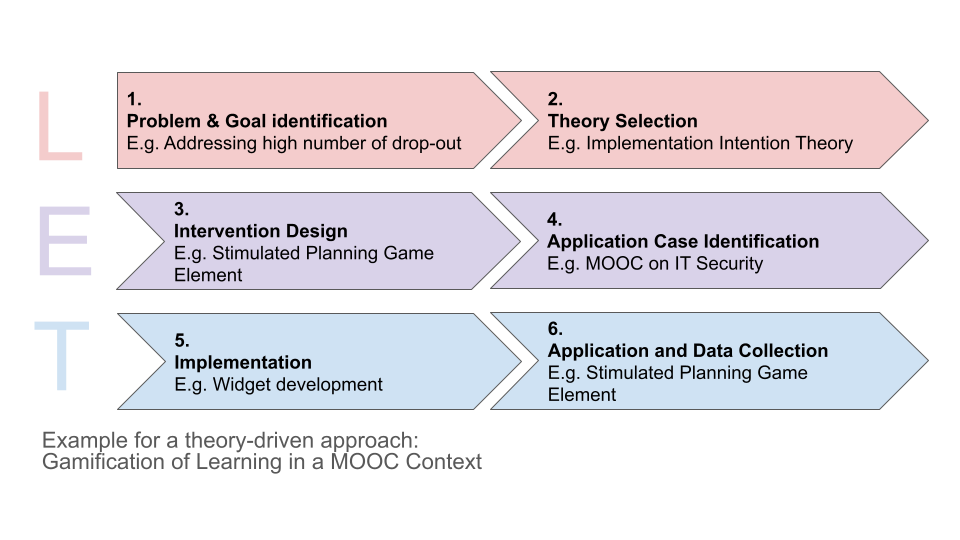
In such an approach challenges include the ability to design the required tools as well as their technical implementation. When approaching the phd project you need to take care about this. If you are rather coming from the learning side, you will probably find the selection of learning theories less challenging than the transfer of your planned intervention into technical concepts, requirements and implementations. This is an aspect to take care about from the beginning of your PhD journey.
Innovation Approach
Starting from the technological end is what we call the innovation approach. In this case you typically start with an emerging technology or a technological innovation that offers new affordances, for which it is yet unclear how they could contribute to learning. A common starting point is then to design and implement an experimental prototype based on the new technology. For instance you use a virtual reality environment to try out an immersive learning scenario.
Depending on the technological innovation at hand, existing learning theories may not or only partly fit. Your research may thus involve experimentation with various prototype settings, to find out what may or may not be useful for education and learning. This may involve technical feasibility studies, usability studies, user experience studies, and measuring effectivity and efficiency with respect to learning. Possible issues to look into include innovation bias, where people are positive just because of the innovative nature. This effect is assumed to disappear over time.
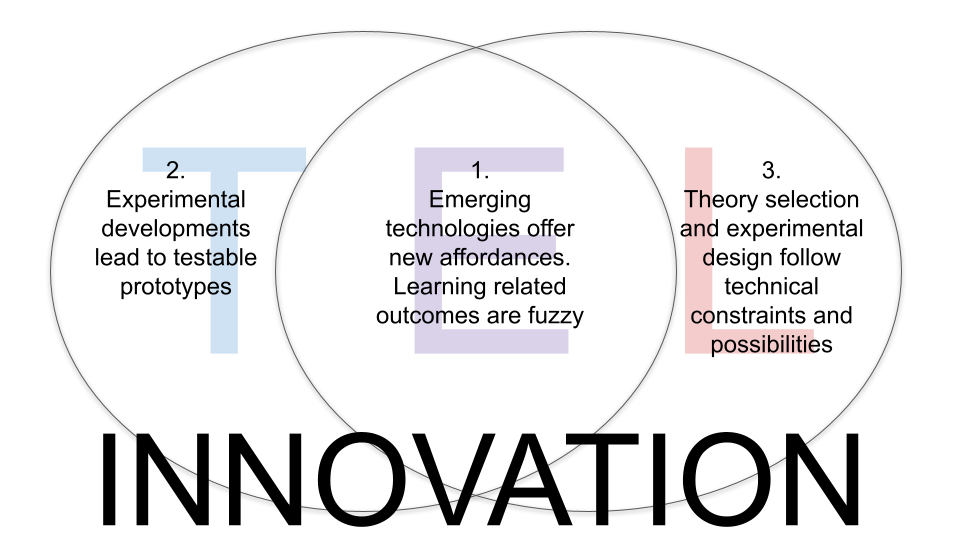
An example for the innovation approach can e.g. be seen in the WEKIT project. In this European research project, we explored the use of wearable technologies and augmented reality for learning and training purposes. To find out how this can possibly be done, we assessed technological affordances of wearables and augmented reality and then derived hypotheses about how we can create appropriate learning solutions. One idea was to record export activities with wearable sensors and recreate augmented reality experiences in 3D which help the learner to reimagine the expert performance. We developed an according prototype system and performed data collections with pilot partners. Results from such piloting activities allow us to continuously refine the solution and the corresponding methodological framework in order to identify useful learning applications and evaluate their effectiveness and efficiency. Outcomes of this kind of research comprise e.g. complex architectures containing various components, methodological frameworks of how to apply the technology in education and evaluation results.
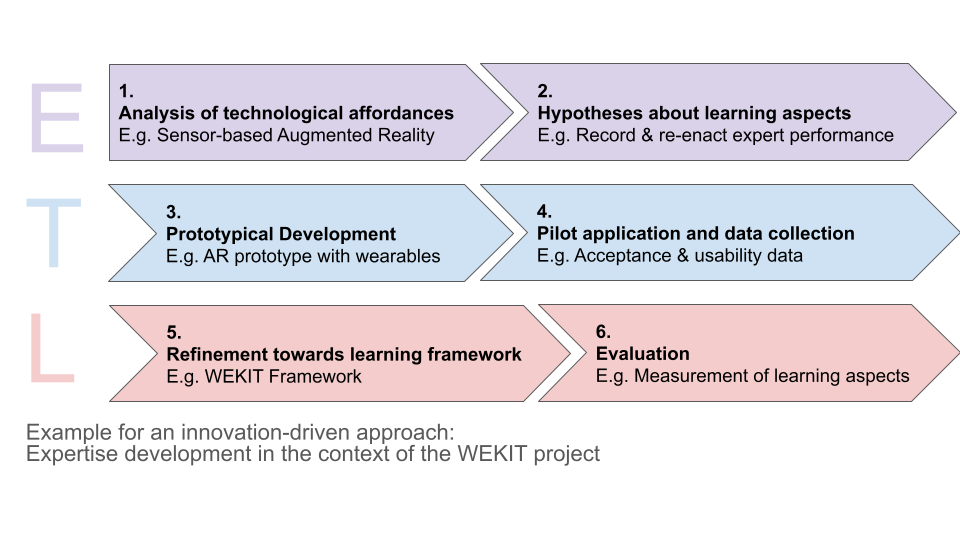
The challenges for you as PhD researcher are also different in this case: typically this kind of research happens as part of larger, multi-partner projects. One question thus is: how do you apply your individual PhD research to such a complex architecture? Where is your individual aspect and how do you balance this with potentially conflicting partner interests. There is no one-size-fits-all solution for this, but it should be made explicit and transparent from the earliest possible moment in such a project situation where the individual interests are.
This challenge is accompanied by the fundamental technological challenge of application design and implementation towards usable prototypes for piloting and evaluation. Here, we assume, that if you are part of such a project, you will have the technological background required.
However, you do not only want to establish a technological innovation, you also want to place it into an educational context in a systematic (i.e. reproducible) manner. One way of doing so is to complement technological developments with a methodological framework. This framework should take the role of bridging the technology to educational design tasks, wherever possible based on existing educational theories.
In our case in the WEKIT project we selected a didactical theory-based model called 4CID (four components for instructional design) and applied it to the technological affordances that we have to create the bridge between technology and instructional design.
But how do you derive a theoretical framework in general? And how do you know if your framework and your software prototype match? This is typically an iterative process, where you look into technological affordances, functionalities on the one side and into learning theories, educational design models, and requirements from the other side and try to identify matches. These matches typically will inform your research design and evaluation procedures.
Service-Oriented Approach
The third and final research approach we present in this chapter is what we call the service oriented approach in TEL. In this case you (or your organization) typically already have an educational technology available in practical use. For instance, your organization may run a MOOC platform and have active users using the platform (e.g. learners, educators, administrative staff). Your organization may already have some problems or issues identified, which require attention. Your role in such a situation may be to further evaluate the situation and from that evaluation you have to derive possible improvements. Therefore you need to first analyze: how well do people use the existing system? How effective/efficient is it? What is the nature of the observed problem? What can we learn from that? Based on these findings you may want to apply research intervention to try out innovations or enhancements to your existing service.
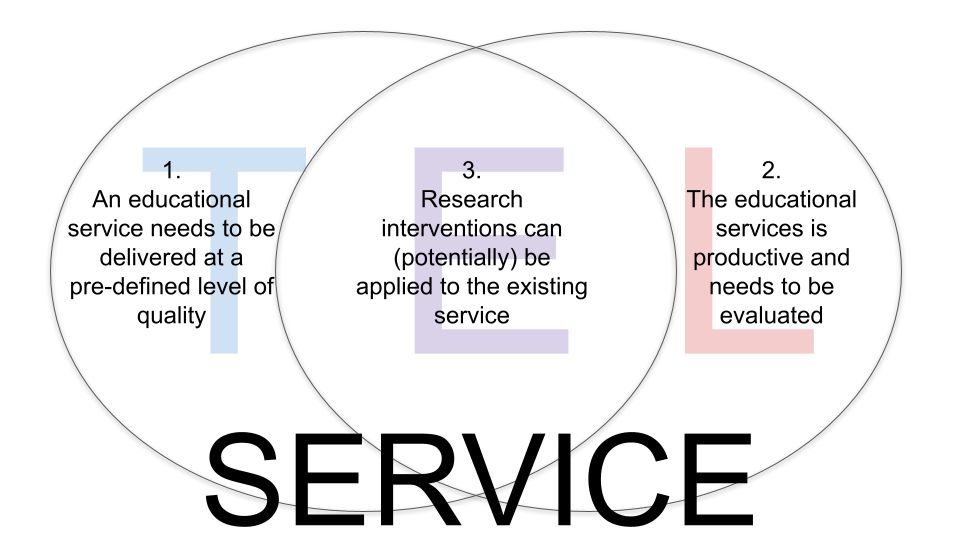
A typical example can be found in the field of MOOC: as opposed to the previous MOOC example, here we assume that the MOOC service is already in place, based on identified requirements and the corresponding implementation. Also the platform is already prepared with educational content and data is collected and available. These steps are probably realized before you as a PhD student become involved. Your task may include evaluating the data, identifying possible problems and addressing these problems with a new research design.

The MOOC platform may comprise, for example, gamification components developed on top of a gamification architecture. Your enhancement could then e.g. comprise the introduction of new gamification elements to this platform. Therefore you need to extend the existing architecture.
Consequently, you are facing the challenge to understand the architecture to be able to perform changes or provide additions to provide the required changes. You may also require organizational support to be able to work on the architecture.
Reality
What to do?
Now that we have an overview of the three identified typical approaches, the question that arises is: if you are a phd student in TEL then are you a “T”, “L”, or “E”? Or are you already “TE” or “EL”? Thus, the question is where do you belong in the presented approaches. In most cases it will not be a perfect match but there may be one of these letters that is basically the main one for you.
Don’t expect a straight path and that you will only do one of these steps and one of these iterations in your PhD research. You may go through even combinations of the approaches and also multiple iterations. This is where your individual research design comes into play. A useful resource to look into is design-based research: a research process model that exactly is specified for situations as they regularly occur in TEL research.
We have seen these three different approaches (theory-based, innovation-based and service-based). In reality, there is a lot of overlap and all of the mentioned aspects come somehow together.

We usually start our research into an existing research group as part of an existing faculty rather than starting from scratch. The faculty will already have an educational program being done. There are already some existing technologies being used for education. Maybe there are even problems identified related to their education and/or technologies. Further, they may even have identified approaches to address and improve these. If this is your situation, you are in a situation, where all three approaches mentioned overlap.
How do we manage that situation? It may seem overwhelming and that’s exactly where the model we presented should help you: how do I identify my initial steps? Where do I start? Do I need to focus on technology first? Do I need to focus on learning theories first? How do I make sure that these things get together to have an enhanced solution? Where do research methods come into play? How do I map design-based research to TEL?
As we are in an interdisciplinary field, most of the PhD students entering this field come from a disciplinary background. You may thus have some gaps: if you’re a computer scientist, you may not know too much about learning theories and how to apply them. If you’re a learning scientist, you don’t know too much about computer science and their methods.
You need to learn some of these things while approaching a TEL PhD project or you need to get support: team up with complementing PhD students in your team or find supporting research team members within your research organization. Otherwise you run the risk that some of these things may become really stressful experiences.
The DE-TEL programme aims at supporting you here: to identify those aspects of your concrete research situation where your gaps, weaknesses, and risks are hidden. Try to identify them as early as possible to be able to address them and finally derive a plan to work on these.
In the field of TEL we should all strive to become the “E” in terms of enhancing learning with technology! Only then we can make sure that our research bridges technological improvements and educational requirements.